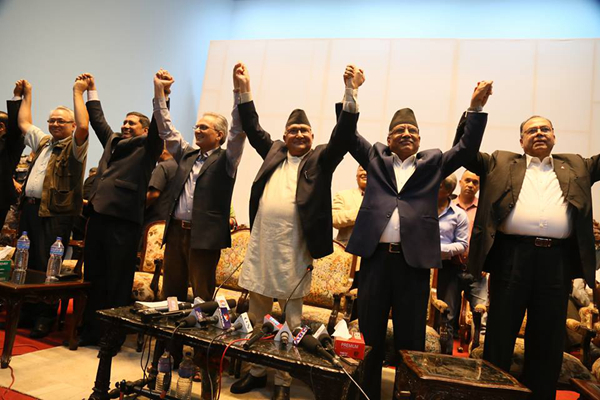 By Ritu Raj Subedi– In a sensational move, Nepal’s two biggest communist parties – CPN-UML and CPN-Maoist Centre – along with the Naya Shakti Party Nepal, announced an alliance and eventual unity ahead of crucial federal and provincial elections this November and December. The announcement set off a ripple of excitement and surprise in political circles.
By Ritu Raj Subedi– In a sensational move, Nepal’s two biggest communist parties – CPN-UML and CPN-Maoist Centre – along with the Naya Shakti Party Nepal, announced an alliance and eventual unity ahead of crucial federal and provincial elections this November and December. The announcement set off a ripple of excitement and surprise in political circles.
The three parties signed a six-point deal to select candidates, create a common election manifesto and evolve a common ideology for subsequent unification. They agreed to name their unified party as the “Communist Party of Nepal.”
As per the accord, the UML and MC will divide the candidacies 60-40, after guaranteeing some seats to Naya Shakti and other smaller allies.
The main objective of the leftist alliance, according to its architects, is to engineer a socialist revolution by gaining a two-thirds majority in government from the upcoming elections. It seeks to restore political stability and put the country firmly on a path of robust prosperity.
On the face of it, this seems an improbable project given bitter rivalry between the UML and Maoist Centre prevailing right up to the moment of announcement, and aiming to form a single powerful communist party. Established some 68 years ago, the Communist Party of Nepal suffered a series of splits, interspersed with occasional mergers.
Historical necessity has now impelled them to forge an electoral alliance and seal their common destiny. Nepal’s mixed yet complicated electoral system barely allows any party to form a majority government. Although the UML emerged as the largest party from the recent local polls, its performance in Province No. 2, covering the eight hardcore districts of the southern plains bordering India, was far from satisfactory, forcing it to do soul-searching.
The Maoist Centre was pushed into a distant third place, while the Naya Shakti Party Nepal of Dr. Baburam Bhattarai was virtually routed.
It has long seemed bizarre for Nepali communist parties to be so often engaged in oppositional politics when almost two-thirds of voters are left-leaning. A divided communist movement has always been a political bonanza for the so-called democratic and rightist parties.
The leaders of the three communist parties have finally grasped this reality and decided to go for alliance and unity to rid the nation of perennial transition and the condition of “controlled instability.”
The news of the left alliance sent shockwaves through the ruling Nepali Congress (NC), and the giant southern neighbor (India) that has been accused of trying to micro-manage the Himalayan nation for so long.
The NC and its fringe allies rushed to form their own alliance to counter it. Upset by the dramatic political development in Nepal, the Indian establishment, media and diplomats have thrown their usual tantrums. They have claimed to detect China’s hand in the formation of communist bloc.
Maoist Centre chair Pushpa Kamal Dahal Prachanda revealed at a recent party secretariat meeting that he faced a threat from India for ditching the NC and allying with the UML.
In fact, a healthy polarization between the left and rightist parties is good for both Nepal’s northern and southern neighbors, because this will help form a strong government essential for stability and predictable foreign relations and conduct.
No doubt, the emergence of the communist alliance is a big blow to India that had been trying to corner the UML by creating a coalition of the NC, MC and Madhesh (southern plains)-based parties.
The latest moves are focusing attention on the role of K.P. Oli, long-time power in the UML who served as prime minister in 2015 and 2016.
Dr. Bhattarai told a local television station: “He [Oli] is not an anti-Indian leader as some suggest. He is a nationalist leader. We want to make both India and China as our partners in development. Rails from Beijing and Gorakhpur come together in Kathmandu. No one should worry about it.”
However, the left alliance has more challenges ahead. Altogether five former prime ministers are included in the bloc. Ensuring an equal space for them and thousands of other aspirant leaders and cadres seems a hard nut to crack. Besides, they must build a common ground to develop coherent ideology and policies acceptable to the rank and file of all three parties.
Its success largely depends on how much its leaders and workers will sacrifice themselves for the common cause of national dignity, independence and prosperity.
(Ritu Raj Subedi is an associate editor of The Rising Nepal. This article was originally published in China.org.cn. on Oct. 15, 2017. Opinion articles reflect the views of their authors, not necessarily those of China.org.cn. and Nepal Foreign Affairs)

